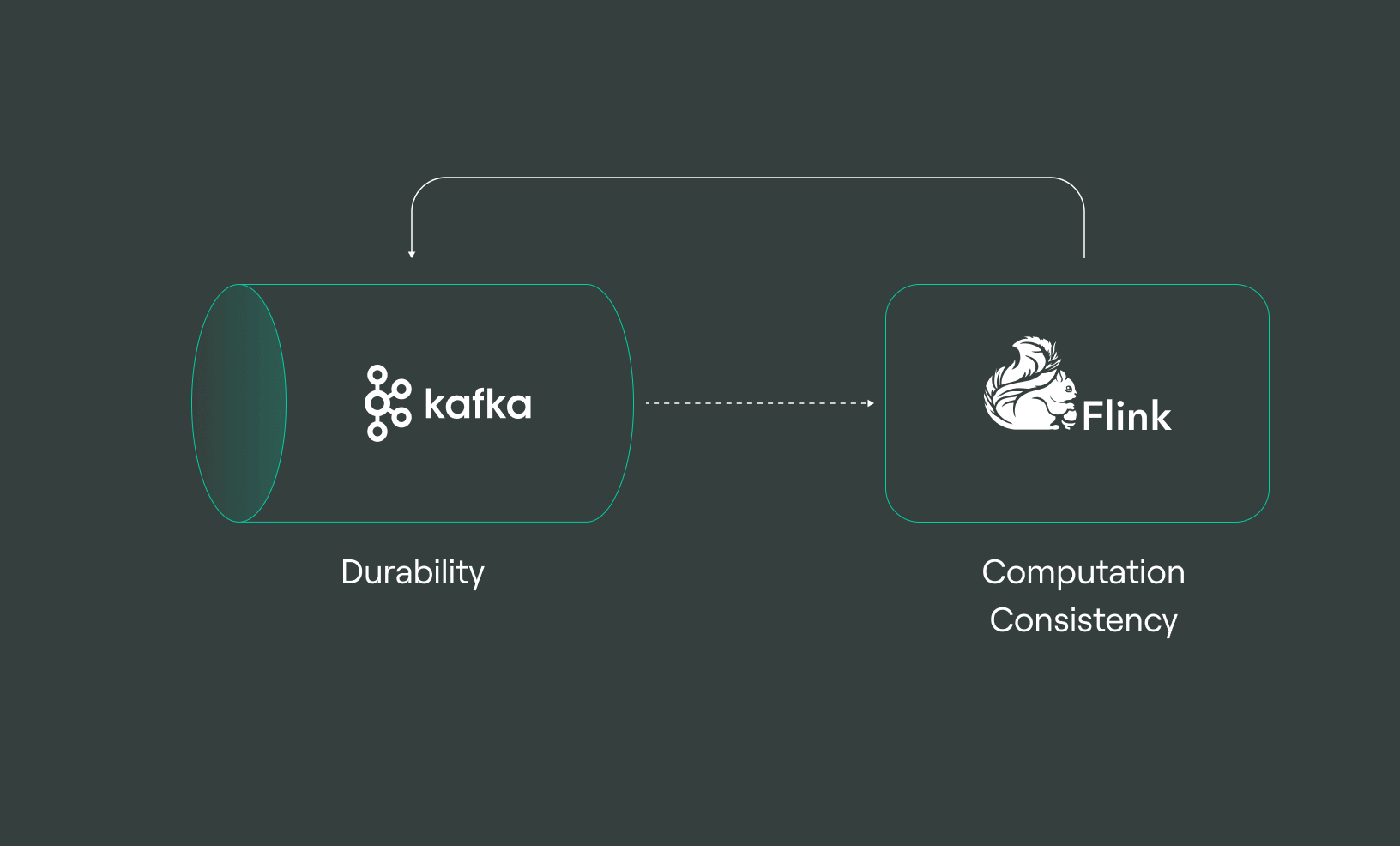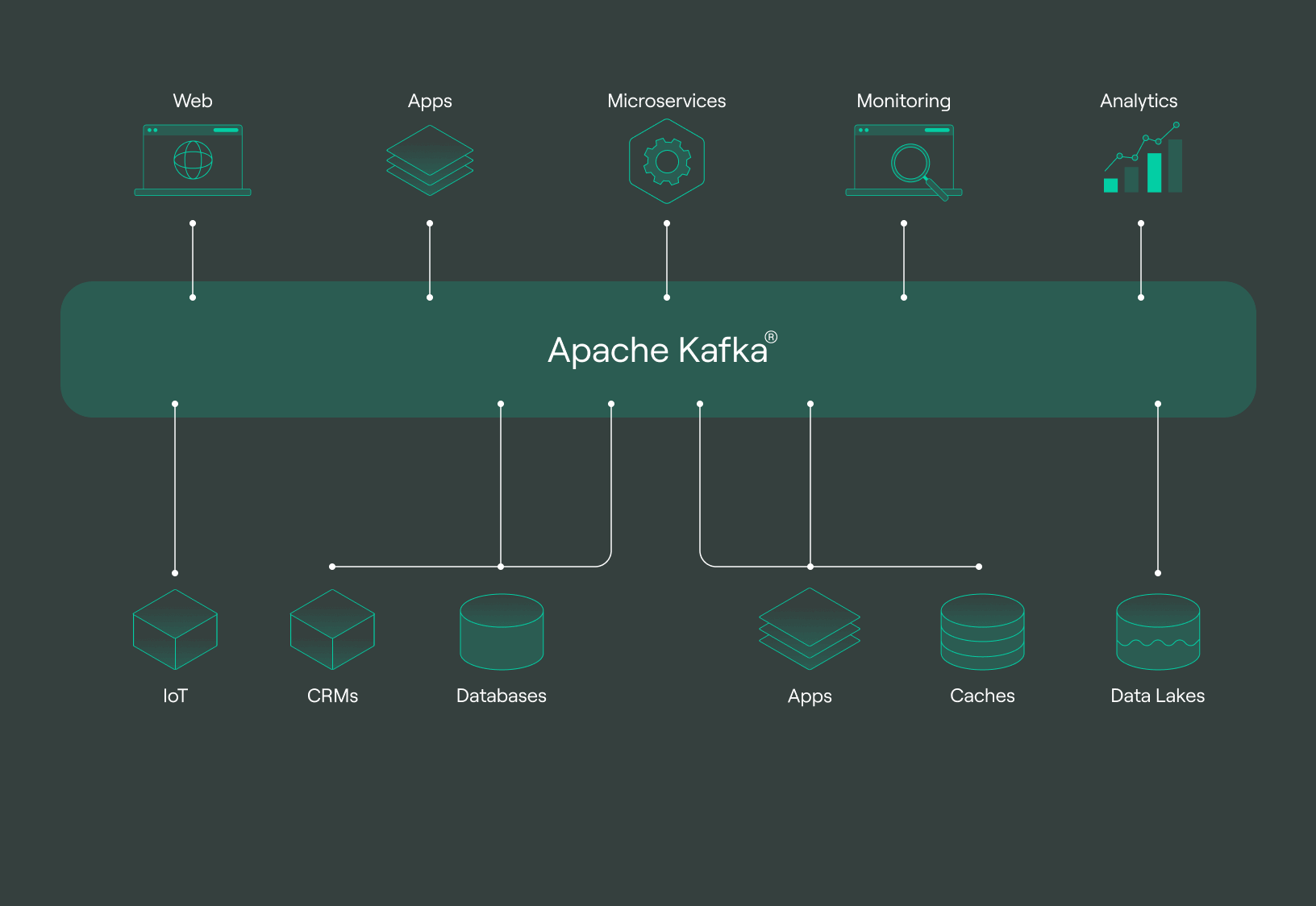
Apache Kafka vs. Flink - Choosing the right streaming data platform
The stream processing market is experiencing rapid expansion with the emergence of numerous platforms. Two prominent frameworks, Apache Flink and Kafka Streams API, have gained considerable popularity and are growing rapidly. While they were originally developed for different purposes, these frameworks now share common features and capabilities in addressing stateful and streaming challenges.

This article will explore the high level differences between Apache Kafka and Flink in deployment, design, and other crucial factors.
What is Apache Kafka?

The Kafka Streams API is a lightweight yet powerful stream processing engine and library designed for building standard Java applications. It provides developers with the tools they need to create a variety of applications, including microservices, reactive stateful applications, and event-driven systems. As an integral part of Kafka, it inherits the scalability and fault tolerance capabilities of Kafka’s distributed architecture.
One of the key advantages of the Kafka Streams API is its embeddable library, which eliminates the need for setting up separate clusters. This means that developers can seamlessly integrate the API into their existing toolstack without the hassle of building and managing additional data infrastructure. This streamlined approach to deployment allows developers to focus their efforts on developing their applications without being burdened by complex deployment processes.
Moreover, by utilizing the Kafka Streams API, teams can leverage the full range of benefits that Kafka offers. This includes robust failover mechanisms, the ability to scale horizontally as needed, and built-in security features. These features give teams confidence in their applications' reliability, scalability, and security.
What is Apache Flink?

Apache Flink is an advanced stream processing framework that handles large-scale data processing tasks effectively. It was specifically developed to tackle immense data volumes, prioritizing real-time data and stateful processing.
Notably, it gained recognition as the first open-source framework to deliver accurate results. It achieved astonishingly low sub-second latency of as little as ten milliseconds. It offers built-in support for high throughput by processing millions of event driven systems per second.
Flink executes self-contained streams within a cluster configuration, allowing independent or resource manager-assisted setup. It excels in seamlessly ingesting data from databases and streams and efficiently processing and consuming streams.
Moreover, Flink’s versatility extends beyond stream processing, as it offers robust batch processing capabilities, utilizing its extensive range of APIs and libraries. It has proven its effectiveness even in large-scale deployments, providing reliable performance.
Flink vs. Kafka
When comparing Flink and Kafka as stream processing systems, it’s important to consider their strengths in different areas.
Use cases
Here are some of Apache Flink’s use cases
-
Fraud detection: Flink can analyze streaming data from credit card transactions to identify and detect fraudulent activity, providing real-time insights.
-
Anomaly detection: This platform can process streaming data from sensors, allowing you to identify anomalies in equipment behavior and take proactive measures.
-
Recommendation engines: It can analyze streaming data from user interactions, enabling you to build personalized recommendation systems for products or services.
Here are some of Kafka’s use cases:
-
Messaging system: Kafka facilitates real-time message exchange between applications, allowing you to send instant notifications to users as soon as they occur.
-
Event streaming: This platform enables the seamless streaming of events from one system to another, making it ideal for scenarios such as streaming sensor data from a factory floor to a cloud-based analytics platform.
-
Log aggregation: It can aggregate logs from multiple sources, such as web servers, making it valuable for troubleshooting and monitoring performance issues.
Technology
Some of Flink’s technological features include:
-
Design: Flink is a general-purpose stream processing framework that is designed to be fault-tolerant and scalable. It is built on the Java Virtual Machine (JVM) and can process data from various sources.
-
API: This platform provides a variety of APIs, including Java, Scala, and Python. These APIs make it easy to develop stream-processing applications.
-
Capabilities: It can be used for various purposes, including streaming analytics, complex event processing, and batch processing. It can also be used to process data from multiple sources, including Kafka, Apache Spark, and Kinesis.
Some of Kafka’s technological features include:
-
Design: Kafka is a distributed streaming platform specifically designed for streaming data. It is built on the ZooKeeper distributed coordination service and can be used to store and deliver streaming data.
-
API: This platform provides a Java API. This API makes it easy to produce and consume data from Kafka topics.
-
Capabilities: It can be used as a messaging system, event streaming platform, or log aggregation tool. It can also be used to process data from various sources, including sensors, web servers, and databases.
Scalability
When it comes to scalability, Apache Kafka and Flink offer different advantages. Flink is particularly adept at scaling horizontally to handle large data volumes. Its distributed processing model allows it to efficiently distribute workloads across a cluster, enabling it to scale effectively for processing massive amounts of data.
On the other hand, Kafka’s scalability shines in terms of accommodating a high number of concurrent users or user facing applications. Kafka’s distributed architecture and partitioning mechanism make it well-suited for handling heavy workloads and simultaneously supporting many consumers and producers.
Performance
Both Apache Flink and Kafka are performant platforms that can be used to process large amounts of data. However, there are some key differences in their performance characteristics.
Flink is generally considered to be more performant than Kafka for streaming analytics applications. This is because Flink can process data more quickly and efficiently than Kafka. Flink also has a lower latency than Kafka, meaning it can process real time data .
Kafka is generally considered to be more performant than Flink for log aggregation applications. This is because Kafka is designed to store and deliver large amounts of data, which is what is typically required for log aggregation. Kafka also has a higher throughput than Flink, meaning it can handle more data per second.
Pricing
Apache Flink and Kafka are both free and open-source frameworks. However, there are some differences in their pricing models.
Flink has no licensing fees or usage restrictions, as it is completely free to use.
Kafka is also free to use for non-commercial purposes. However, for commercial use, there are two pricing models:
-
Kafka on Confluent Cloud: This is a fully-managed Kafka service hosted by Confluent. Prices start at $0.0002 per message.
-
Confluent Enterprise: This self-managed Kafka distribution includes additional features and support. Prices start at $1,000 per month.
Features
Apache Flink is a distributed stream processing framework that can be used for both batch and streaming data processing. It is highly scalable, fault-tolerant, and performant. Flink uses a dataflow model, making writing complex streaming applications easier.
Kafka is a distributed streaming platform primarily for storing and processing real-time data. It is highly scalable, fault-tolerant, and has low latency. Kafka uses a messaging model, making integrating with other systems more accessible.
Ease of Use
Both Apache Flink and Kafka are relatively easy to use. However, there are some key differences in their ease of use.
Flink is a more complex framework than Kafka, so learning how to use it may take longer. However, Flink’s framework provides a more comprehensive set of features, so it may be more flexible and powerful for some applications.
Kafka is a simpler framework than Flink, so it may be easier to learn how to use it. However, Kafka does not provide as many features as Flink, so it may be less flexible and powerful for some applications.
Support and services
Both Apache Flink and Kafka benefit from robust user and developer communities. However, their support and services differ in notable ways.
Flink is backed by the Apache Software Foundation, offering essential resources like documentation, mailing lists, and bug trackers. Additionally, Flink has a range of commercial providers, including DataArt and StreamSets, that provide support and services.
The Apache Software Foundation also supports Kafka and receives further support from Confluent. As a commercial company, Confluent provides various Kafka-related products and services, such as Kafka on Confluent Cloud, Confluent Enterprise, and Confluent Control Center.
Community
The communities surrounding Apache Flink and Kafka differ in several ways. Flink boasts a highly active community, evident from the number of users on mailing lists, answered questions on Stack Overflow, and stars on its GitHub repository.
In contrast, Kafka possesses a more established community, as demonstrated by its longer history, numerous commercial support providers, and abundance of pre-built tools and libraries.
Integration
Flink and Kafka can be integrated in many ways. Here are some of the most common integration patterns:
-
Flink as a source for Kafka: Flink can read data from various sources, including files, databases, and other streaming platforms. This data can then be sent to Kafka for further processing or storage.
-
Kafka as a source for Flink: Kafka can store data that Flink can then read for processing or analysis. This is an excellent way to scale out Flink applications, as Kafka can handle large data.
-
Flink as a sink for Kafka: Flink can be used to write data to Kafka for storage or further processing. This is a good way to ensure data is not lost, as Kafka provides durable storage.
-
Kafka as a sink for Flink: Flink can aggregate data from multiple sources and then write it to Kafka for storage or further processing. This is a good way to decouple different parts of an application and to ensure that data is not lost.
Security
Both Flink and Kafka offer a variety of security features to protect data in transit and at rest. However, each framework’s security features varies significantly in a few crucial ways.
Flink offers a more comprehensive set of security features than Kafka. Flink supports a variety of authentication methods, including SASL/Kerberos, OAuth2, and TLS. Flink also supports a variety of authorization methods, including role-based access control (RBAC) and fine-grained authorization.
Kafka offers a more limited set of security features than Flink. Kafka supports SASL/PLAINTEXT and TLS for authentication. Kafka also supports ACLs for authorization.
Monitoring
Flink and Kafka offer a variety of monitoring features to help you track the performance and health of your applications. However, there are some key differences in the monitoring features offered by each framework.
Flink surpasses Kafka in terms of monitoring capabilities, offering a diverse array of metrics for the JVM, cluster, and jobs. Flink further enhances monitoring by including the Flink Dashboard and the Flink REST API.
Kafka falls short of Flink in terms of monitoring capabilities, providing a narrower range of available metrics for brokers, topics, producers, and consumers. It also offers limited monitoring tools, including the Kafka Manager and Kafka REST API. Additionally, Kafka as a service may have fewer comprehensive monitoring features than Flink’s native monitoring capabilities.
Deployment
Flink offers deployment options, including a standalone mode for easy setup, but with limited scalability and resilience. Cluster mode provides greater scalability and resilience, though setup and management complexity increases. Deploying Flink on Kubernetes simplifies scaling and management.
Similarly, Kafka offers a standalone mode for easy setup but limited scalability and resilience. Cluster mode provides better scalability and resilience, while increasing setup and management complexity. Deploying Kafka on Kubernetes simplifies scaling and management.
Ecosystem
Flink and Kafka have a large and active ecosystem of tools and libraries. However, there are some key differences in the ecosystems of the two frameworks.
Flink has a more comprehensive ecosystem of tools and libraries than Kafka. This is because Flink has been around longer than Kafka and has had more time to develop a larger ecosystem. Flink’s ecosystem includes tools for various tasks, such as data ingestion, stream processing, and machine learning.
Kafka has a smaller ecosystem of tools and libraries than Flink. However, Kafka’s ecosystem is more focused on stream processing. Kafka’s ecosystem includes tools such as kafka connet for tasks such as data ingestion, stream processing, and event streaming.
Connectors
Both Flink and Kafka have a number of connectors that allow them to connect to other data sources and sinks. However, there are some key differences in the connectors the two frameworks offer.
Flink surpasses Kafka in terms of connectors, offering a wider range of options. Flink’s extensive collection of connectors, developed over a longer period, supports various data sources and sinks like databases, files, and other streaming platforms.
Kafka has a smaller set of connectors than Flink. However, Kafka’s connectors are more focused on stream processing. Kafka’s connectors include connectors for data sources and sinks such as other Kafka topics, files, and external systems.
Comparison table
The following table concisely compares key features between Flink and Kafka, including monitoring capabilities, deployment options, and connector availability.
|
Feature |
Flink |
Kafka |
|
Programming model |
Dataflow programming model |
Messaging model |
|
Use cases |
Stream processing, batch processing, machine learning |
Stream processing, event streaming |
|
State management |
Distributed state |
No distributed state |
|
Scalability |
Highly scalable |
Horizontally scalable |
|
Fault tolerance |
Exactly-once semantics |
At-least-once semantics |
|
Deployment |
Standalone, cluster, Kubernetes, cloud |
Standalone, cluster, Kubernetes, cloud |
|
Connectors |
Large and comprehensive |
Smaller but focused on stream processing |
|
Ecosystem |
Large and active |
Smaller but growing |
Pros and cons of Apache Kafka
When checking the strengths of Kafka, it becomes important to consider the benefits and drawbacks it presents across different utilization scenarios.
Pros of Apache Kafka
-
Scalability: Kafka is horizontally scalable, so it can be easily scaled to handle more traffic.
-
Reliability: Kafka is fault-tolerant, which means it can continue to operate even if some of the nodes in the cluster fail.
-
Durability: Kafka stores messages on disk, meaning they are not lost if a node fails.
-
Flexibility: Kafka can be used for various purposes, including real-time data processing, event streaming, and batch processing.
-
Ecosystem: Kafka has a large and active ecosystem of tools and libraries, making integrating with other systems easy.
Cons of Apache Kafka
-
Complexity: Kafka can be complex to set up and manage.
-
Performance: Kafka can have high latency for some use cases.
-
Cost: Kafka can be expensive to deploy and operate.
-
Security: Kafka can be a security risk if it is not properly configured.
Pros and cons of Flink
To fully evaluate Flink, analyzing its pros and cons in different application scenarios is crucial.
Pros of Flink
-
Scalability: Flink scales well horizontally and vertically, allowing it to handle larger data volumes and complex processing tasks.
-
Fault tolerance: Flink is fault-tolerant, thanks to its checkpointing mechanism that enables it to continue operating even if some nodes fail.
-
Efficiency: Flink is highly efficient regarding memory and CPU usage, utilizing a streaming dataflow model for optimal data processing.
-
Ease of use: Flink is relatively user-friendly, particularly for developers familiar with Java or Scala. It offers a wide range of APIs for seamless integration with other systems.
Cons of Flink
-
Complexity: Flink can be complex to set up and manage, especially for large-scale deployments.
-
Learning curve: Flink has a steeper learning curve than other streaming frameworks. This is because Flink is a more complex framework with a wider range of features.
-
Limited ecosystem: Flink has a smaller ecosystem of tools and libraries than some other streaming frameworks. This can make finding the right tools for a specific use case more difficult.
How DoubleCloud helps you with Apache Kafka?
DoubleCloud is a managed service for Apache Kafka. Managed kafka on DoubleCloud helps users and companies to deploy, manage, and scale Kafka clusters easily. DoubleCloud provides some features that make it easy to use Kafka, including:
-
Automated deployment: DoubleCloud takes care of deploying and managing Kafka clusters, relieving you from the burden of managing the underlying infrastructure.
-
Scalability: DoubleCloud easily scales Kafka clusters to accommodate varying workloads, ensuring they can handle demanding tasks effectively.
-
High availability: DoubleCloud ensures high availability of your Kafka clusters, guaranteeing data accessibility even in node failures.
-
Security: DoubleCloud provides robust security features, including encryption, authentication, and authorization, to safeguard your Kafka clusters.
-
Monitoring: DoubleCloud offers comprehensive monitoring capabilities for Kafka clusters, enabling you to monitor cluster performance and health closely.
Final words. Apache Flink vs. Kafka: Which is right for me?
This article compares Kafka and Flink, two versatile frameworks for stream processing. We have examined their key differences, strengths, and weaknesses. While Kafka Streams is a library that operates on top of Kafka, Flink is an independent framework. Kafka Streams offers tight integration with Kafka, whereas Flink provides more flexibility for working with various streaming platforms.
They both support load balancing which is a technique used to evenly distribute incoming network traffic across multiple resources such as network link or servers.
In terms of data processing models, Kafka Streams follows a messaging model, while Flink utilizes a dataflow model. Kafka Streams is generally considered easier to learn and use compared to Flink. However, Flink offers more advanced capabilities and is suitable for a wider range of applications.
Ultimately, choosing the most suitable framework depends on your specific needs and requirements. We believe that gaining an organizational perspective through this article will empower you to make informed choices that align with your objectives and goals.

DoubleCloud Managed Service for Apache Kafka
Fully managed open-source Apache Kafka® service for distributed delivery, storage, and real-time data processing.
Frequently asked questions (FAQ)
Does Apache Flink use Kafka?
Does Apache Flink use Kafka?
Yes, Apache Flink can use Kafka as a source or sink for data. Flink can read data from Kafka topics and write data to Kafka topics.
How do Kafka and Flink differ in terms of their primary use cases?
How do Kafka and Flink differ in terms of their primary use cases?
What is the difference between Kafka consumer and Flink?
What is the difference between Kafka consumer and Flink?
How do Kafka and Flink integrate with other systems in the data processing pipeline?
How do Kafka and Flink integrate with other systems in the data processing pipeline?
Start your trial today



